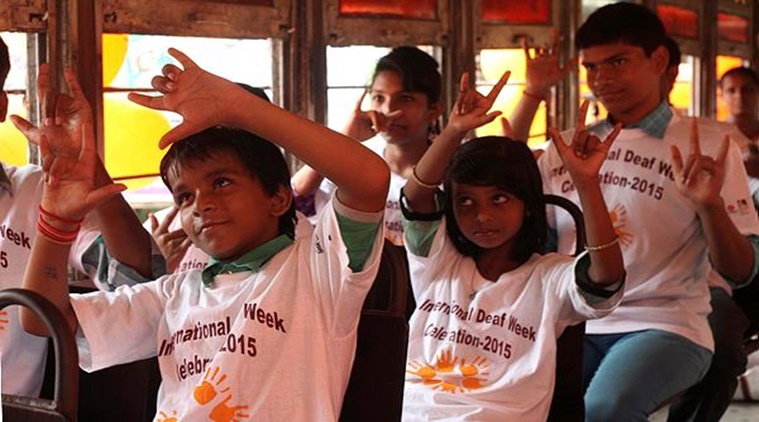Academicians and the community of people associated with the education of hearing and speech impaired have expressed skepticism over standardisation of the Indian Sign Language (ISL), a move advocated in the National Education Policy (NEP) 2020.
“Having different sign languages is not a problem for speech or hearing impaired people. I am sure the deaf community is proud of the diversity of the sign language. The real issues are different. We do not have proper research on the variation and diversity of ISL in India to standardise it. Nor a data corpus to understand it. Empowering a language user community does not require a common sign language,” AS Narayanan, a hearing-impaired himself and president of the National Association of the Deaf (NAD), told indianexpress.com through a written conversation. Narayanan was closely associated with developing the ISL dictionary.
The NEP, released earlier this year, had said, “Indian Sign Language will be standardised across the country, and national and state curriculum materials developed, for use by students with hearing impairment. Local sign languages will be respected and taught as well, where possible and relevant. NIOS will develop high-quality modules to teach Indian Sign Language, and to teach other basic subjects using Indian Sign Language.”
Narayanan, however, said the pressing need is not to standardise the different signs used by members, but lack of quality education content available in that language. “The need for educational materials in local or national sign language produced by the best available signers which match quality standards, both technically and content-wise, is the primary need. Secondly, training programs for deaf people to become professionals in the area of their respective education. Hearing-impaired professionals are the key to resolving deaf education,” he said.
He believes that a separate committee of experts needs to be set-up to have an education standard for hearing and speech impaired students. The NAD had also written letters to the Ministry of Education demanding to set up an expert committee to develop a national curriculum framework in Indian Sign language. “We are waiting for a response from the ministry very soon,” said Narayanan.

To sign or not to sign: Dilemma within academia
The development of educational content in sign language is lacking because the academicians are divided over teaching through sign languages to students. Many also believe that since sign language is not accepted in mainstream society, learning it can make a student secluded instead.
“Sign Language in India has been looked through myths and challenges, so far dividing educationists and society into two schools of thought – one’s who support the idea of sign language and those who support oral-aural methods of learning. Later is followed largely due to the lack of availability of content and training to teachers in sign language,” said Gaurav Raheja, professor at Department of Architecture and Planning, IIT-Roorkee, who has participated in several initiatives of the government, including the accessible India campaign. He was also a member of the team behind drafting the accessibility guidelines for Indian Railways.
He believes that standardisation of ISL also needs customisation of education content and teacher training in ISL. He also suggests teaching ISL to ‘mainstream’ society to popularise the language.
“We look forward to an Indian of the future when ‘common people’ would also learn this language and allow better integration of deaf in our mainstream society… The major barrier to such steps is the awareness and support of society at large,” said Raheja.
The road ahead
Raji Gopal, who heads the undergraduate programs at the National Institute of Speech and Hearing (NISH), Thiruvananthapuram, Kerala believes NEP’s mention of sign language will bring the much-needed focus to the issue.
“The more you use the signs for communication, for education and in other areas, the more familiar it becomes. However, it is a huge challenge spreading this in a country which is estimated to have roughly 18 million deaf people. Accessibility is one of the biggest challenges for them. Not many of the 18 million are even aware of the RPWD Act 2016 or NEP 2020. The non- standardised version will continue to be used by deaf communities unless the standardised form of sign language is made accessible,” she said.
Gopal says there should be awareness around the topic and ISL should be introduced as a second or even third language in the curriculum. “Enforcing the RPWD Act by which media channels will have sign language interpreters for all their programs, all meetings and programs conducted will have interpreters, including sign language as a subject in the special teacher training programs, starting bilingual programs for the deaf from early intervention to higher education are some of the solutions,” she said.



No comments:
Post a Comment